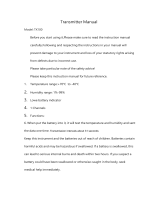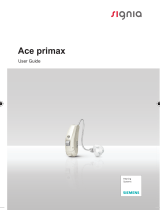Page is loading ...

1
Pure 700, Pure 500
User Guide

2

1
Dear Customer,
Congratulations! You have selected the new Pure hea-
ring instruments from Siemens.
These instructions as well as the guidance from your
Hearing Care Professional will help you understand how
your new Pure hearing instruments work.
If you have any further questions, please contact your
Hearing Care Professional.
Introduction
3

A
12
Contents
3
4
5
6
7
8
9
10
11
Your Pure hearing instrument 6
Intended use 7
General notes on safety 8
Handling of standard and rechargeable batteries 10
Low battery indicator 1
- 0
Inserting the battery 1
- 1
Removing the battery 1
- 2
Inserting and removing your hearing instrument 13
Inserting your hearing instrument 1
- 3
Removing your hearing instrument 1
- 4
Turning your hearing instrument on and off 15
Changing the hearing program 16
e2e wireless 2.0 17
Maintenance and care 18
Domes and Receiver Molds 19
C-Guard 1
- 9
Daily cleaning 2
- 0
Replacing the Dome 2
- 1
Replacing the C-Guard of the Receiver Mold 2
- 2
Disassembling the Receiver Mold 2
- 2
12
4

A
1
16
14
15
2
Handling of the Receiver Unit 23
Remove Receiver Unit 2
- 3
Attach Receiver Unit 2
- 3
Accessories 24
Remote control 2
- 4
Charger 2
- 5
Tek wireless enhancement 2
- 6
Troubleshooting tips 28
Technical information 30
Disposal information 32
Your hearing instrument configuration 33
13
17
18
5

Features:
1 Receiver Unit
2 Dome
3 Battery compartment
4 Push Button
5 Microphone Cover
6 Receiver Mold
7 C-Guard
2
7
1
2
3
4
Your Hearing Care Professional offers an assortment of re-
ceiver lengths and Dome sizes to best fit your ear.
CAUTION
Risk of injury caused by incorrect use of Domes.
Always wear the Receiver Unit with the Dome.
X
Make sure that the Dome is completely attached to X
the Receiver Unit.
If the Dome remains in your ear, have it removed by a X
medical professional.
Replace the Dome if it breaks. X
Insert the Receiver Unit with the Dome carefully and X
not too deeply into the ear.
Use the Receiver Unit and Dome only in the manner X
described in this user guide.
3
Your Pure hearing instrument
7
6
5
6

Hearing instruments are intended to improve the hearing
of hearing impaired persons. Diagnosis and prescription
of a hearing instrument must be performed by hearing
health specialists, e.g. ENT doctors, audiologists or acou-
sticians.
Read and follow the instructions of this user guide to
avoid injuries or damage to the hearing instrument.
Symbols:
Be aware of information marked with the warning symbol
WARNING, CAUTION or NOTICE!
WARNING points out a situation that could
lead to serious injuries,
CAUTION indicates a situation that could lead
to minor and moderate injuries.
NOTICE
NOTICE indicates possible property
damage.
Advice and tips on how to handle your
hearing instrument better.
Instruction. Indicates that something has to
be done.
4
Intended use
7

NOTICE
Your hearing instrument is sensitive to extreme heat,
high humidity, strong magnetic fields (> 0.1T), X-rays
and mechanical stress.
Do not expose your hearing instrument to extreme
X
temperature or high humidity.
Do not leave it in direct sunlight.
X
Do not wear it in the shower or when you apply make- X
up, perfume, aftershave, hairspray or suntan lotion.
Do not wear your hearing instrument when you are
X
exposed to short-waves, a strong magnetic field, a high
frequency field or X-rays.
General notes on safety
5
WARNING!
Choking hazard posed by small parts.
Keep hearing instruments, batteries and accessories
X
out of children‘s reach.
If swallowed consult a physician or hospital immedia-
X
tely.
If infants, small children or mentally disabled persons
X
need to wear hearing instruments ensure adequate
supervision.
In some countries restrictions for the usage of wireless
equipment exist.
Refer to local authorities for further information.
X
8

WARNING
Risk in explosive environments, e.g. mining areas!
Don't use your hearing instruments (and remote con-
X
trol) in areas where there is a danger of explosions.
NOTICE for batteries
Leaking batteries damage the instrument.
Remove batteries when the instrument is not in use for
X
a prolonged period of time.
Turn your hearing instrument off when not in use to
X
preserve the battery.
General notes on safety
5
9

Remove the tab on your X
batteries only when you are
ready to use them.
The positive (+) side of the batteries is always the
X
smooth side.
Always keep spare batteries with you.
X
Handling of standard and rechargeable batteries
Low battery indicator
Your Hearing Care Professional can activate an acoustic
signal to inform you when the battery is nearly empty.
If you hear an acoustic signal or experience low amplifica-
tion power, replace the battery.
Use standard batteries or rechargeable batte- X
ries in your hearing instruments.
Always use size 312 batteries. X
Charge the rechargeable batteries before first X
use.
original size
6
10

Handling of standard and rechargeable batteries
Inserting the battery
Open the battery compartment completely X
using your fingernail as shown in the illus-
tration.
Insert the proper size battery so that
X
the "+" symbol on the battery aligns
with the "+" marked on the battery
compartment.
Close the battery compartment by X
gently pressing the bottom of the door
upward with your finger tip.
Do not force the door shut. If it does not
close easily, check to see if the battery
was inserted properly.
When the battery door is completely closed, your hearing
instrument is ready for use.
6
11

Handling of standard and rechargeable batteries
Removing the battery
Open the battery compartment complete- X
ly.
Normally the battery drops out when the
X
compartment is completely open. If the
battery does not come out, lightly tap the
instrument or push the battery out with a
pencil as shown.
Do not throw used batteries into household trash. X
Return them to your Hearing Care Professional for
environmentally correct disposal.
6
12

Inserting and removing your hearing instrument
7
NOTICE
Do not use lubricant when you insert the Dome/ ear-
X
mold, because it may clog the sound outlet.
Inserting your hearing instrument
Turn your hearing instrument off. X
Hold the receiver with the Dome/ Receiver Mold bet- X
ween your thumb and index fin-
ger and insert it carefully into the
ear canal.
You may find it helpful to pull
your ear slightly upward or to the
back.
Place your hearing instrument
X
behind your ear.
Turn your hearing instrument on.
X
NOTICE
For hearing instruments with earmold, handle by
X
holding the earmold. Do not pull the tube.
13

Removing your hearing instrument
Turn your hearing instrument off. X
Hold the Receiver Unit/ Receiver Mold X
between your thumb and index finger
and carefully pull it out.
You may find it helpful to lightly push
your ear from the back.
CAUTION
The ear tip needs to be attached properly. If the
X
ear tip remains in the ear, it has to be removed by
Hearing Care Professional.
Inserting and removing your hearing instrument
7
14

Turn on:
Press the push button for 2 seconds to turn the X
instrument ON.
Turn off:
Press the push button for 2 seconds to turn the X
instrument OFF.
Power-on delay
Your hearing instrument is equipped with a „power-on-de-
lay“ feature which can be activated by your Hearing Care
Professional. This allows you to turn the hearing instru-
ment on with an automatic delay, so that you may insert
the hearing instrument into your ear without experiencing
unpleasant feedback (whistling).
The delay can be programmed by your Hearing Care Pro-
fessional to be 6, 12 or 18 seconds.
8
Turning your hearing instrument
on and off
You can also use the remote control to turn the hea-
ring instrument on and off.
15

9
Changing the hearing program
Your hearing instruments offer up to 5 hearing pro-
grams for specific listening environments.
Each time you press the program button, your hea-
ring instruments switch to the next program, confir-
ming each change with an acoustic signal.
Example
Turn your hearing instruments on.
X
It is automatically in program 1. You want to change to
program 2.
Press the program button once.
X
You hear the acoustic signal for program 2.
You are now in program 2.
If you are wearing two hearing instruments, the hearing
program will be changed on both instruments simultane-
ously if e2e wireless 2.0 is activated.
Your Hearing Care Professional can write down the perso-
nal program configuration of your hearing instrument on
page 33.
Your Hearing Care Professional can activate or deactivate
the acoustic signals in your hearing instruments.
You can also use the remote control to change the
hearing program.
16

Your hearing instruments are equipped with e2e (ear-to-
ear) wireless 2.0 technology.
Advantages of the wireless functionality:
Automatically adjusts both hearing instruments simulta-
neously to different listening situations.
Allows use of accessories, e.g. a remote control.
Provides synchronization of the settings in the system. If
you change the volume or program on one hearing in-
strument, the other hearing instrument is automatically
adjusted.
Your Hearing Care Professional can activate or deactivate
the wireless functionality of your hearing instruments.
The performance of e2e wireless 2.0 may be affected
by electromagnetic interference – e.g. from a compu-
ter monitor or halogen lamp system controlled by a
switching power supply.
Move away from the source of interference if you
X
experience difficulty.
10
e2e wireless 2.0
17

NOTICE
Do not put the hearing instruments in
X
water.
Your hearing instruments are highly sensitive systems.
Proper care and handling will ensure the best possible
performance.
Clean instruments regularly to prevent damage to the
X
hearing instruments and to avoid health problems.
Clean your hearing instruments with a soft, dry tissue,
X
as necessary.
If the hearing instruments sound distorted or weak ask
X
your Hearing Care Professional to exchange the micro-
phone cover.
Place your hearing instruments in a "dry aid kit" with a
X
special moisture-attracting capsule overnight.
Ask your Hearing Care Professional for special care sets
X
and further information on how to keep your hearing
instruments in good condition.
11
Maintenance and care
18

Your hearing instrument has either a Dome or a Receiver
Mold.
C-Guard
Domes and Receiver Molds include integrated C-Guard
wax protection system.
Domes and Receiver Molds
12
Full functionality of Domes and Receiver Molds is only
assured with a working C-Guard.
Have the C-Guard exchanged approximately every
X
three months.
Receiver MoldDome
19

Daily cleaning
Cerumen (ear wax) on the C-Guard affects sound quality.
Remove wax with a soft tissue.
X
No other tools are required.
The Dome/ Receiver Mold cleans best
right after taking the hearing instru-
ments off. This way Cerumen can not dry
and harden.
If there is dried cerumen on the C-Guard,
X
moisten the soft tissue with a cerumen
solvent
Dab the C-Guard with the moistened tissue and wait a
X
short period of time, this will loosen the cerumen.
NOTICE
Domes, Receiver Molds and C-Guards are easily dama-
ged when handled wrongly.
Never use brushes or sharp objects for cleaning.
X
Never use running water or immerse the hearing in- X
strument.
Never use pressure or rotating action while cleaning.
X
Don't spray cerumen solvent directly onto the X
C-Guard!
Do not pull the receiver out of the Receiver Mold.
X
12
Domes and Receiver Molds
20
/


